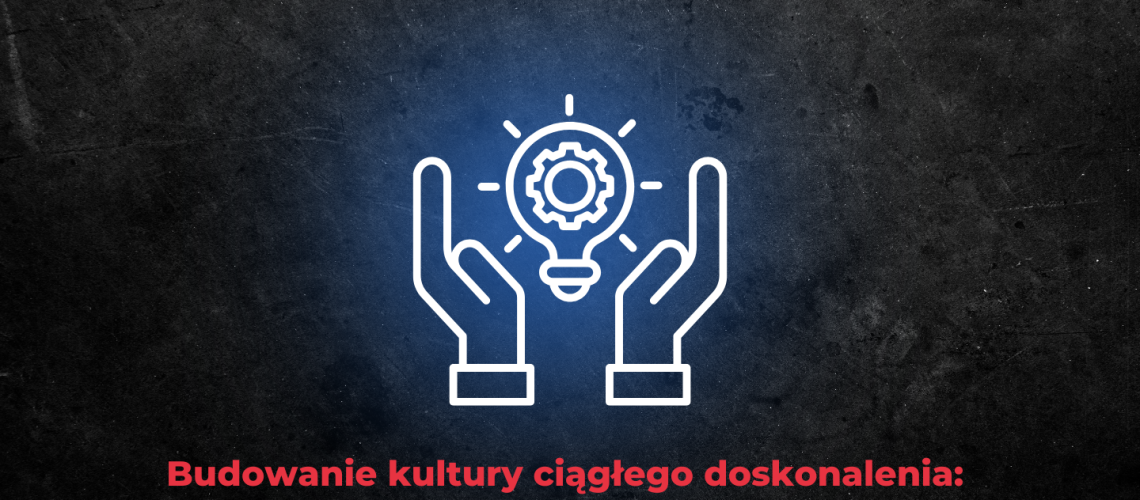In today's rapidly changing business world, organizations that seek to remain competitive must continually improve their standards. Building a culture of continuous improvement is becoming a key element in this process. The goal of such a culture is not only to improve operational efficiency, but also to create an atmosphere where innovation, change and adaptation are the order of the day. What challenges do managers face in implementing a culture of continuous improvement, and how do they successfully overcome them? In this article, we will discuss key aspects of the process and solutions to help managers successfully implement change in their organizations.
Table of Contents:
- What is a culture of continuous improvement?
- Challenges in building a culture of continuous improvement
a. Resistance to change
b. Lack of commitment
c. Lack of resources and support
d. Insufficient communication - Solutions for managers in the process of building a culture of continuous improvement
a. Engage leaders
b. Training and support for employees
c. Use of technology
d. Regular feedbacks and celebration of successes - Benefits of building a culture of continuous improvement
- Sherlock Waste as a tool to support a culture of improvement
- Summary
1. what is a culture of continuous improvement?
A continuous improvement culture is an organizational philosophy that promotes the continuous development and optimization of a company's processes. This approach assumes that even the smallest changes in processes, products and services can lead to significant improvements in performance. It is important that employees at all levels of the organization feel responsible for proposing and implementing improvements.
Continuous improvement is based on several pillars:
- Employee involvement - employees are the ones who are able to spot areas for improvement and innovate.
- Data analysis - fact-based decision-making for improvements.
- Iterative process - improvements are implemented gradually, and each change is tested and optimized.
- Feedback - an ongoing process of gathering feedback and adjusting activities to meet the needs of the organization.
2 Challenges in building a culture of continuous improvement
While the idea of continuous improvement is extremely valuable, its implementation comes with a number of challenges that managers must overcome. Here are the most common of these:
a. Resistance to change
Many employees fear change, especially when it means modifications to their daily duties. Resistance to change is a natural occurrence in any organization, and overcoming it requires the right approach. Managers must act as change leaders, convincing the team of the benefits of making improvements.
b. Lack of commitment
For a culture of continuous improvement to be effective, all employees must be involved. Without their active participation in the change process, it will be more difficult to achieve success. Often the problem is a lack of motivation or a sense that improvement proposals will not be implemented. Managers must therefore create an environment in which employees feel responsible for the success of the organization.
c. Lack of resources and support
Implementing an effective continuous improvement culture requires investment - in both time and resources. Managers often have to contend with budget constraints or lack of adequate tools to effectively manage improvement processes. Strategies must therefore be developed to make the best use of available resources.
d. Inadequate communication
Effective communication is the key to success in the continuous improvement process. Lack of transparency about goals, expectations and progress can lead to frustration and decreased employee engagement. Managers need to ensure regular meetings, reporting of results and open exchange of information.
3. solutions for managers in the process of building a culture of continuous improvement
While the challenges in implementing a culture of continuous improvement are many, there are specific solutions to help managers overcome them and successfully implement change.
a. Engagement of leaders
For change to be effective, it must start at the top. Managers and team leaders must actively participate in the continuous improvement process and be a role model for their employees. Involving leaders in the company's improvement processes motivates the entire team and creates an atmosphere of trust.
b. Training and support for employees
For employees to actively participate in a culture of continuous improvement, they must be properly prepared. Investing in training on improvement tools such as Kaizen, Lean or Six Sigma helps create competent teams that can effectively implement change. Training should include both technical aspects and the development of interpersonal skills, such as communication and conflict resolution.
c. Use of technology
Process improvement support technologies, such as Sherlock Waste, allow efficient data management, process analysis and progress monitoring. With these tools, managers can quickly identify areas for improvement, implement changes and evaluate their effectiveness. Introducing the right technologies speeds up the process of implementing a culture of continuous improvement and allows measuring the results of activities in real time.
d. Regular feedbacks and celebration of successes
Continuous improvement requires regular feedback. Managers should provide employees with opportunities to provide feedback and ideas, and regularly monitor progress in implementing changes. It is also important that successes are recognized and celebrated. Even small accomplishments can significantly motivate the team to keep moving forward.
4 Benefits of building a culture of continuous improvement
With the right approach, introducing a culture of continuous improvement can bring a number of benefits to an organization:
- Increased efficiency: Improved processes lead to savings in time and resources, resulting in better financial performance.
- Increased employee engagement: Employees who have a real impact on process improvement feel more engaged and motivated.
- Increasing innovation: Continuous improvement fosters a creative approach to problems, leading to new and innovative solutions.
- Improved quality of products and services: Implementing improvements leads to an increase in the quality of products and services offered, which affects customer satisfaction.
5. Sherlock Waste as a tool to support a culture of improvement
Sherlock Waste is a platform that supports companies in building a culture of continuous improvement. Sherlock Waste identifies areas for improvement by allowing employees to report areas of waste and ideas for improvement. The tool is particularly helpful for organizations seeking to effectively manage processes and eliminate waste.
Summary
Building a culture of continuous improvement is a process that requires committed managers, adequate resources and the use of modern technology. Despite challenges, such as resistance to change or lack of commitment, there are many effective solutions to help overcome these difficulties. Implementing a culture of improvement brings numerous benefits to organizations - it increases efficiency, employee engagement and the quality of products and services. Technologies such as Sherlock Waste provide valuable support in this process, enabling organizations to quickly implement change and measure its effectiveness.
👉 Schedule a meeting now and start a revolution of innovation in your organization!










